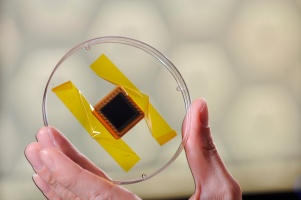
This week when SpaceX’s Falcon 9 rocket blasted off, heading for the International Space Station, it brought with it a novel three-dimensional solar cell design that will begin its test phase in space.
The experimental module contains 18 test cells and will be installed on the exterior of the station to study the cells’ performance and their ability to withstand space conditions.
The module will also study a low-cost copper-zinc-tin-sulfide (CZTS) solar cell formulation. Altogether the module launched contains four types of photovoltaic devices: 3D cells based on conventional cadmium telluride, 3D cells based on CZTS materials, traditional solar cells that were produced at Georgia Tech, and planar cells based on CZTS.

“We want to see both the light-trapping performance of our 3D solar cells and how they are going to respond to the harshness of space,” said Jud Ready, a principal research engineer at the Georgia Tech Research Institute (GTRI) and an adjunct professor in the Georgia Tech School of Materials Science and Engineering. “We will also measure performance against temperature, because temperature has an influence on the performance of a solar cell.”
The 3D cells were created by coating miniature carbon nanotube “towers” with a photo-absorber that captures sunlight from all angles, and could possibly boost the amount of power obtained from the small surface areas that many spacecraft possess. The cells would absorb light from any direction, and eliminate the need for mechanical devices that are used to aim PV modules toward the sun.
“The CZTS photovoltaic arrays were built using the readily available elements copper, zinc, tin and sulfur to replace rarer CIGS – copper, indium, gallium and selenium – which are used in similar thin-film solar cells,” said Ready. “The CZTS approach produces an efficient photo-absorber using earth-abundant materials that cost around a thousand times less than rare-earth elements like indium, gallium and selenium.”
One virtue of CZTS photovoltaic material is its electron band structure, Ready explained. Like CIGS, CZTS is a direct band gap material. In semiconductor physics, this means incoming solar photons are able to emit current-producing electrons directly, rather than moving through power-robbing intermediate states as indirect band gap materials, like silicon, require.
The 3D capability could be valuable on the International Space Station, which is exposed to about 16 sunrises daily as it orbits Earth every 92 minutes at 17,150 mph. The 3D towers can leverage the sun’s rays for longer periods than traditional 2D (flat) designs, which really only work when the sun is directly overhead.
“With our 3D design, as the sun’s angle increases more surface is exposed and there’s a growing chance that photons will enter,” Ready said. “Also, 3-D technology provides more opportunity for photons to bounce around between the towers, increasing the likelihood they will be converted to electron hole pairs and produce mobile charge carriers.”
After their six-month mission, the solar cells will head back to Earth via cargo ship where the research team will assess the cells’ performance and look for damage from radiation and other space hazards.
“If it can survive in space, which is the harshest of environments from the standpoint of wide temperature swings, radiation and numerous other factors, then we can be confident it will work well down on Earth,” said Ready.
Story via Georgia Tech.

Comments are closed, but trackbacks and pingbacks are open.